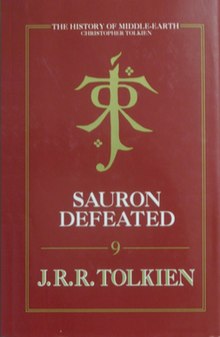 The front cover of Volume 9 | |
| Editor | Christopher Tolkien |
|---|---|
| Author | J. R. R. Tolkien |
| Language | English |
| Genre | High fantasy |
| Publisher | George Allen & Unwin (UK) Houghton Mifflin (US) |
Publication date | 1983 to 1996 |
| Publication place | United Kingdom |
| Media type | Print (hardback and paperback) |
| Pages | 12 volumes |
| Preceded by | Unfinished Tales |
| Followed by | The Children of Húrin |
The History of Middle-earth is a 12-volume series of books published between 1983 and 1996 by George Allen & Unwin in the UK and by Houghton Mifflin in the US. They collect and analyse much of J. R. R. Tolkien's legendarium, compiled and edited by his son Christopher Tolkien. The series shows the development over time of Tolkien's conception of Middle-earth as a fictional place with its own peoples, languages, and history, from his earliest notions of "a mythology for England" through to the development of the stories that make up The Silmarillion and The Lord of the Rings. It is not a "history of Middle-earth" in the sense of being a chronicle of events in Middle-earth written from an in-universe perspective; it is instead an out-of-universe history of Tolkien's creative process. In 2000, the twelve volumes were republished in three limited edition omnibus volumes.[1]
Scholars including Gergely Nagy and Vincent Ferré have commented that Tolkien had always wanted to create a mythology, but believed that such a thing should have passed through many hands and be framed by annotations and edits of different kinds. When Christopher Tolkien, a philologist like his father, edited the History, he created an editorial frame, inadvertently reinforcing the mythopoeic effect that his father wanted.
- ^ "The History of Middle-earth". An Illustrated Tolkien Bibliography. TolkienBooks.net. 2014. Retrieved 16 July 2014.